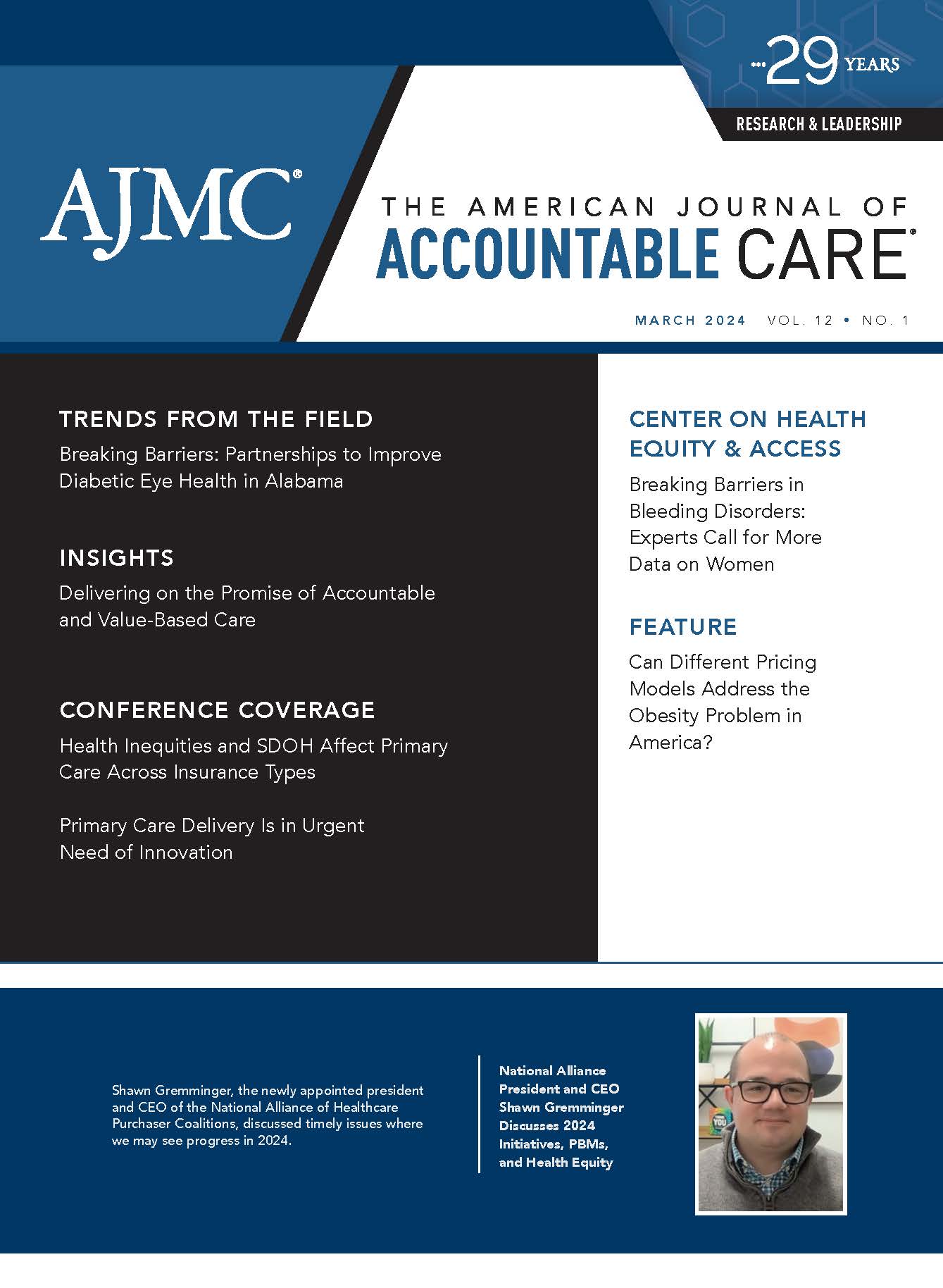- Center on Health Equity & Access
- Clinical
- Health Care Cost
- Health Care Delivery
- Insurance
- Policy
- Technology
- Value-Based Care
Breaking Barriers in Bleeding Disorders: Experts Call for More Data on Women
“These autosomal diseases, from an inheritance standpoint, affect men and women equally, but because of their impact on the gynecological system and menses, women are often affected much more than men," hematologist Donna DiMichele, MD, explains.
The American Journal of Accountable Care. 2024;12(1):38-40. https://doi.org/10.37765/ajac.2024.89525
There is a critical need to bridge gaps in awareness, diagnosis, and management of bleeding disorders among women, who have historically been excluded from research but have unique needs in terms of the management of these conditions. With CDC estimates suggesting up to 1 in every 100 women and girls in the United States has a bleeding disorder—many of whom are not aware of their condition—insight into such disorders in this population is crucial.1
Heavy menses is a key symptom of bleeding disorders among women but there's limited research and treatment options for those who suffer from it.

Due to the myth that hemophilia can affect only men, women with mild hemophilia who carry the gene are often overlooked when it comes to symptoms and treatment options. But genetic testing for potential carriers of hemophilia, especially women related to individuals with the condition, is important.
There is a movement to classify hemophilia carriers as individuals with mild hemophilia A or B based on clotting factor levels to highlight the seriousness of their condition, Margaret Ragni, MD, MPH, professor of medicine and clinical and translational research in the Division of Hematology/Oncology at the University of Pittsburgh, director of the Hemophilia Center of Western Pennsylvania, and American Society of Hematology expert, explained in an interview with The American Journal of Managed Care® (AJMC®) Center on Health Equity & Access.
Carriers can be identified if they have a 50% chance of carrying the gene, and testing is crucial because it determines factor levels, influencing decisions about medical procedures like epidurals. Many carriers may not be aware due to historical social taboos and lack of awareness among doctors.
“Some women who are carriers don’t even know they’re at risk of being carriers,” Ragni said, “because, don’t forget, 30 years ago, [when] we had the AIDS epidemic, people didn’t even want to talk about it.... And so women were the last to know, and certainly, their doctors, who were not hemostasis doctors, they were pediatricians or good upstanding internists or gynecologists, don’t think of those things. Why would they?”
A discrepancy exists in how treatments for hemophilia are tested in clinical trials, primarily focusing on men. This can limit the scope of treatments for women who generally have higher hormone levels, Ragni said. Many women use hormones for birth control, but some struggle with low-dose estrogens and require higher doses to manage heavy menstrual bleeding. It's unclear if combining lower hormone levels with certain drugs is effective.
“It’s...one of those issues when a carrier’s first symptom and most common symptom is heavy menstrual bleeding,” she said. “You would think that in the realm of things, you would ask the [questions]: ‘Do you have any other kind of bleeding? What else is going on? Is anybody a bleeder in your family?’ Those questions could really pave the way for a lot more things.”
This is not isolated to women with mild hemophilia, but also to women with any type of bleeding disorder. In one of Ragni's recent studies, she investigated treatment options for heavy menstrual bleeding in women with von Willebrand disease, a rare blood disorder.
The comparative analysis revealed that a pill version, tranexamic acid, significantly reduced blood loss when compared with intravenous recombinant von Willebrand factor.2 Additionally, Ragni championed research exploring hormonal therapies that has shown promising results, which drew inspiration from hemophilia research and indicates a progressive shift in addressing gender bias in medical studies.
Lynn Malec, MD, MSc, medical director of the Comprehensive Center for Bleeding Disorders, associate investigator at The Versiti Blood Research Institute, associate professor of medicine and pediatrics at the Medical College of Wisconsin, and coauthor of Ragni's study, also spoke with AJMC.
“Even the concept of women who have hemophilia is something that has evolved reasonably recently, because of the idea of the inheritance being X [chromosome] linked,” she said.
The mild hemophilia designation is imperative, according to Malec, so that women can have access to all the therapies and care teams that their male counterparts would.
“Some of my hope, being very passionate about and thinking about women and girls with bleeding disorders, is: How do we then take the innovation that’s happened in the hemophilia space and really try to apply that to women and girls?” she said. “I think low-hanging fruit is having more data around menstrual control.”
Both Malec and Ragni acknowledged hemophilia treatment breakthroughs in 2023, such as the approval of a once-weekly recombinant antihemophilic factor, Fc-VWF-XTEN fusion protein-ehtl treatment (Altuviiio; previously known as efanesoctocog alfa) for hemophilia A. However, these data included only men, therefore creating gaps in knowledge about how the treatment might affect women differently.3
“The aspect of looking at the use of therapies for menstrual control is something that has been left out of the hemophilia space,” Malec said.
Donna DiMichele, MD, of Donna DiMichele Consulting and former deputy director of the Division of Blood Diseases and Resources in the National Heart, Lung, and Blood Institute at the National Institutes of Health, highlighted the intentional exclusion of women from research endeavors. Despite being affected by these conditions, women find themselves conspicuously absent from clinical trials and studies, with a historical focus solely on boys and men. In various interventional and epidemiologic studies on hemophilia, the systematic exclusion of women has perpetuated a significant knowledge gap, leaving their unique challenges and needs unaddressed.
“These autosomal diseases, from an inheritance standpoint, affect men and women equally, but because of their impact on the gynecological system and menses, women are often affected much more than men; they’re much more symptomatic,” DiMichele told AJMC.
These conditions include von Willebrand disease and ultrarare factor deficiencies, and women with these diseases can have not only problems with menstruation and heavy menses but also serious difficulties in pregnancy and childbirth.
“And yet, we know very little,” DiMichele said. “There have never been any longitudinal studies. These are very rare diseases, but you would think that collectively—nationally and internationally—we would have done more in terms of international registries that would be giving us a lot better information.”
Despite recent breakthroughs in hemophilia treatment, the exclusion of women from research endeavors remains a glaring issue. DiMichele’s insights into this exclusion and the resulting knowledge gap emphasize the urgent need for international registries and more extensive studies. The impacts of this exclusion include dismissal of symptoms, limited treatment options, and serious challenges in pregnancy and childbirth for women with blood disorders.
The revelation that the first and most common symptom for carriers is heavy menstrual bleeding underscores the need for comprehensive questioning during medical assessments. The studies conducted by experts like Ragni and Malec shed light on effective treatment options for women with bleeding disorders, challenging existing gender biases in medical research.
In conclusion, the urgent need to address the awareness, diagnosis, and management of bleeding disorders in women, as highlighted by the CDC and experts in the field, cannot be overstated. The prevailing myth that hemophilia affects only men has resulted in the oversight of women, particularly those with mild hemophilia who carry the gene. The crucial role of genetic testing in identifying carriers is often overlooked due to historical taboos and lack of awareness.
The movement to classify hemophilia carriers as individuals with mild hemophilia A or B is a significant step toward recognizing the severity of their condition. The disparity in clinical trial focus on men limits the scope of treatments for women, especially those with higher hormone levels, necessitating a more inclusive approach in medical studies.
In light of these challenges, the efforts of organizations like the CDC and the Foundation for Women and Girls with Blood Disorders are paramount. Bridging these gaps and addressing the unique needs of women with bleeding disorders is not only a medical imperative but also a crucial step toward achieving equity and inclusivity in health care.
Author Information: Ms Grossi is an employee of MJH Life Sciences™, parent company of the publisher of The American Journal of Accountable Care®.
REFERENCES
- Byams VR, Miller CH, Bethea FM, Abe K, Bean CJ, Schieve LA. Bleeding disorders in women and girls: state of the science and CDC collaborative programs. J Womens Health (Larchmt). 2022;31(3):301-309. doi:10.1089/jwh.2022.0008
- Ragni MV, Rothenberger SD, Feldman R, et al. Recombinant von Willebrand factor and tranexamic acid for heavy menstrual bleeding in patients with mild and moderate von Willebrand disease in the USA (VWDMin): a phase 3, open-label, randomised, crossover trial. Lancet Haematol. 2023;10(8):e612-e623. doi:10.1016/S2352-3026(23)00119-9
- Grossi G. Margaret Ragni, MD, MPH: women who are hemophilia carriers need treatment options. HCPLive. March 16, 2023. Accessed January 17, 2024. https://www.hcplive.com/view/margaret-ragni-women-hemophilia-carriers-need-treatment-options


